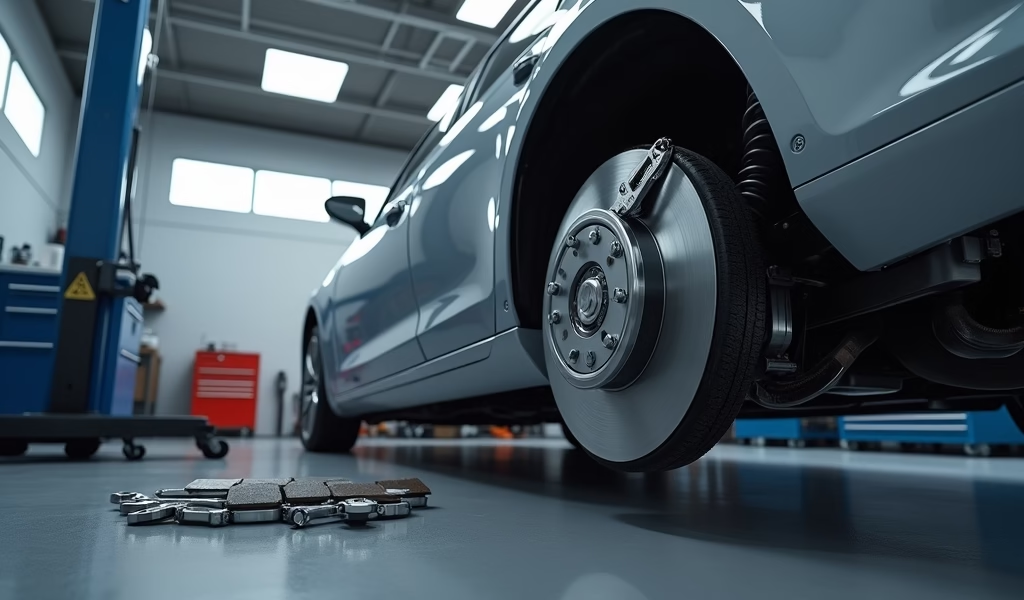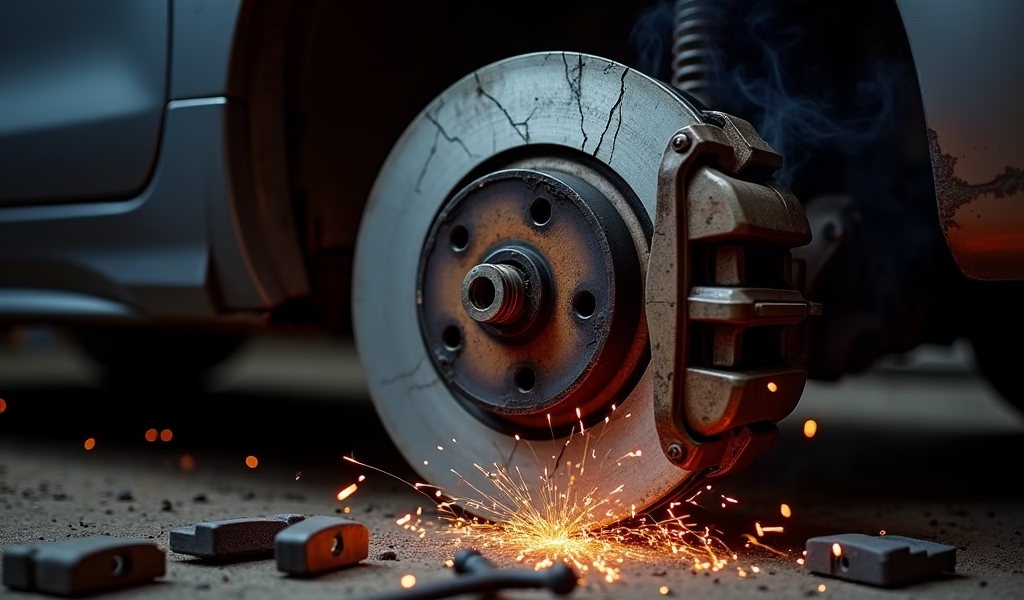Overview
This article provides seven practical strategies to save money on brake repairs while maintaining safety, including comparing quotes, using quality aftermarket parts, bundling services, finding promotions, addressing issues early, choosing independent shops over dealerships, and learning basic maintenance. The guide explains brake job costs across different vehicle types (typically $150-$500 per axle for standard vehicles), weighs DIY versus professional options, and emphasizes that proactive brake maintenance prevents more expensive emergency repairs while ensuring optimal vehicle safety.
Table of Contents
- Understanding Brake Job Costs: What You’re Really Paying For
- Average Brake Job Costs by Vehicle Type and Service Level
- DIY vs. Professional Brake Jobs: Weighing Your Options
- Saving Tip #1: Shop Around and Compare Quotes
- Saving Tip #2: Consider Aftermarket Parts
- Saving Tip #3: Bundle Services for Better Deals
- Saving Tip #4: Look for Promotions and Coupons
- Saving Tip #5: Don’t Wait Until It’s an Emergency
- Saving Tip #6: Consider Independent Shops vs. Dealerships
- Saving Tip #7: Learn Basic Brake Maintenance
- Conclusion: Balancing Cost and Safety
- Frequently Asked Questions
Understanding Brake Job Costs: What You’re Really Paying For
When that brake pedal starts feeling spongy or you hear the dreaded squeal, you’re probably already worrying about your wallet. I get it—unexpected brake repair costs can throw a wrench in anyone’s budget. As a mechanic with 15 years under my belt, I’ve seen folks shocked by brake job quotes, mostly because they don’t understand what they’re actually paying for.
A complete brake job isn’t just swapping out a couple of parts. It’s a comprehensive service that ensures one of your vehicle’s most critical safety systems works flawlessly. Your brakes literally stand between you and a potential accident—they deserve proper attention.
What exactly goes into that brake job cost? Labor typically accounts for 30-50% of the total, while parts make up the rest. Those parts might include brake pads, rotors (sometimes called discs), calipers, brake fluid, and occasionally hardware like clips and shims. Depending on your vehicle and the extent of wear, you might need all of these components replaced or just a few.
The quality and type of parts significantly influence your final bill. Premium ceramic pads will cost more than semi-metallic ones but might offer better performance and longevity. Similarly, drilled and slotted rotors demand a higher price than standard ones but provide improved heat dissipation for those who drive aggressively or in mountainous terrain.
Average Brake Job Costs by Vehicle Type and Service Level
Let’s talk real numbers. According to recent market data, the average brake service cost ranges widely depending on your vehicle type and exactly what work you’re having done. For a basic brake pad replacement on a standard sedan, you might pay between $150-$300 per axle. Add rotor replacement, and you’re looking at $250-$500 per axle.
Luxury vehicles and performance cars? Those numbers can easily double. A complete brake job on all four wheels of a high-end European model might run $1,200-$2,500 or more. These vehicles often require specialized parts and have more complex braking systems.
SUVs and trucks generally fall somewhere in the middle, with typical costs ranging from $200-$400 per axle for pad replacement and $350-$600 when rotors are included. These vehicles have larger, heavier braking components, which naturally cost more.
It’s worth noting that according to a Consumer Reports study, brake repairs rank among the top five most expensive maintenance items for most vehicles over their lifetime. They typically need attention every 30,000 to 70,000 miles, depending on driving habits and conditions.

DIY vs. Professional Brake Jobs: Weighing Your Options
One of the biggest ways to save on brake jobs is handling the work yourself, but let’s be honest about what that entails. DIY brake work can save you 50-70% on labor costs, but it requires tools, knowledge, and time—sometimes lots of time.
For a first-timer, a complete brake job on one axle might take 3-4 hours. The learning curve is steep, and you’ll spend a good chunk of that time referencing videos or manuals. An experienced DIYer might knock it out in 1-2 hours per axle. The trickiest parts for novices usually include properly compressing the caliper pistons and ensuring the correct torque specifications on all fasteners.
What tools will you need? At minimum: jack and jack stands, lug wrench, socket set, C-clamp or caliper compression tool, brake fluid, and gloves. You might spend $100-$150 on basic tools if you don’t already have them. Factor that into your savings calculation.
Beyond the time and tools, consider the risk. Brakes are critical safety components—there’s zero margin for error. If you’re not 100% confident in your mechanical abilities, this might not be the place to start your DIY journey. As automotive expert and mechanic James Wilson notes, “Approximately 5% of accidents related to mechanical failure involve brake system issues, many of which stem from improper installation or maintenance.”
Professional mechanics also have specialized tools like brake lathes and electronic diagnostic equipment that can identify issues you might miss. They can spot problems with related components like wheel bearings or suspension parts that could affect braking performance.
If you do decide to tackle a DIY brake job, set aside a full day for your first attempt, work in daylight, and have a backup transportation plan in case you encounter unexpected challenges.
Saving Tip #1: Shop Around and Compare Quotes
This might seem obvious, but it’s amazing how many folks accept the first quote they receive. In my years turning wrenches, I’ve seen price differences of $200+ for the same brake job between shops in the same town. Take an hour to make some calls or use online quote tools—that hour could save you more than you’d earn working overtime.
When requesting quotes, be specific about what you want. Ask for separate pricing on parts and labor, and confirm whether they’re using OEM (Original Equipment Manufacturer) or aftermarket parts. Some shops automatically quote premium components when you might be perfectly happy with standard parts.
Don’t just compare the bottom line—ask what’s included. A slightly higher quote that includes brake hardware, caliper lubrication, and a thorough system inspection might actually deliver better value than a bare-bones lower offer.
Pro tip: Ask about a free brake inspection if you’re not sure exactly what work is needed. Many shops offer these at no charge, hoping to earn your business for the actual repair. This gives you an accurate assessment of your brake condition without commitment.
Saving Tip #2: Consider Aftermarket Parts
The great OEM versus aftermarket debate has raged in auto shops for decades. Here’s the unvarnished truth: many aftermarket brake components are perfectly adequate for everyday driving and can save you 20-40% compared to OEM parts.
However, quality varies wildly. Stick with reputable brands like Wagner, Raybestos, or Bosch rather than the bargain-basement options. A quality mid-range aftermarket pad often performs as well as or better than OEM at a lower price point.
For rotors, the savings can be even more significant. Aftermarket rotors from trusted manufacturers typically cost 30-50% less than dealer parts while maintaining comparable quality and performance for normal driving.
Where OEM parts might make more sense is for high-performance vehicles or if you plan to keep your vehicle for many years. They’re typically designed specifically for your make and model, ensuring optimal fit and performance.
If you’re working with a mechanic, ask if they’d install parts you purchase separately. Some shops are willing to do this, though they might not warranty the parts themselves. This approach can combine the savings of aftermarket components with professional installation.

Saving Tip #3: Bundle Services for Better Deals
Mechanics love efficiency. If you’re already paying them to have your vehicle on the lift with the wheels off, they can often perform additional services at a reduced rate. Consider scheduling your brake replacement alongside other maintenance items like tire rotation, wheel bearing inspection, or suspension work.
Many shops offer package deals that can save you 10-15% compared to booking these services separately. For instance, a “brake and alignment” special is common since wheel alignment directly affects how evenly your brake pads wear.
This bundling strategy works especially well for scheduled maintenance. If you know your vehicle is due for a 60,000-mile service that includes brake inspection, plan ahead and budget for potential brake work at the same time.
When discussing bundle options with your mechanic, be clear about your budget constraints. A good shop will help prioritize what needs immediate attention versus what can safely wait a bit longer.
Saving Tip #4: Look for Promotions and Coupons
Brake service is highly competitive, and shops regularly run promotions to attract customers. National chains like Midas, Firestone, and Meineke frequently offer brake specials, particularly during slower seasons (typically late winter and mid-summer).
Don’t overlook manufacturer rebates, either. Brake component manufacturers like Akebono, Wagner, and others occasionally offer mail-in rebates when you purchase their products through authorized retailers or service centers.
Local independent shops might not advertise as heavily, but many offer seasonal specials or new customer discounts. Follow their social media pages or join their email lists to stay informed about upcoming promotions.
Membership programs can yield substantial savings, too. Warehouse clubs like Costco or Sam’s Club offer discounted prices on automotive services for members. Similarly, AAA membership often includes discounts at approved repair facilities.
When using coupons or promotional offers, always read the fine print. Some deals apply only to basic services and may not cover premium parts or additional labor if complications arise. Ask for a final quote that includes any potential additional charges before authorizing work.
Saving Tip #5: Don’t Wait Until It’s an Emergency
The most expensive brake job is almost always the emergency one. When you’re forced to get repairs immediately because your brakes are severely compromised, you lose all negotiating power and may face additional costs for expedited service or damaged components.
Brake wear is predictable and gives plenty of warning signs. That initial squeal is your first hint—it’s typically from wear indicators designed to alert you before damage occurs. At this stage, you might only need pad replacement, which is the most affordable brake service.
Wait too long, and those pads will wear completely through, damaging the rotors (which then must be replaced or resurfaced). Further neglect can damage calipers or other hydraulic components, potentially tripling your repair costs.
According to data from RepairPal, addressing brake issues at the first sign of wear versus waiting until complete failure can save an average of $225-$300 per axle. Plus, you’ll have the luxury of time to shop around, use coupons, or schedule service during promotional periods.
Establish a relationship with a trusted mechanic who provides honest assessments of your brake condition during routine oil changes or tire rotations. They can help you plan and budget for brake work before it becomes urgent.
Saving Tip #6: Consider Independent Shops vs. Dealerships
Dealerships excel at specialized knowledge of your specific vehicle and access to factory parts. However, this expertise typically comes at a premium—dealership labor rates average 20-40% higher than independent shops.
For most brake jobs on common vehicles, well-established independent shops offer comparable quality at significantly lower prices. Many independent mechanics are former dealership techs who bring that same expertise to their own businesses with lower overhead.
Specialty shops that focus primarily on brake work can be particularly good values. Their higher volume of brake-specific jobs often means they’ve refined their processes for efficiency, and they may get better pricing on brake components through bulk purchasing.
For exotic or uncommon vehicles, the dealership advantage becomes more pronounced. Their specialized tools and training might justify the higher cost, especially if your vehicle has unique braking system characteristics.
When choosing an independent shop, check their certifications. ASE certification (particularly in brake systems) indicates the technician has demonstrated professional-level knowledge. Also review their warranty terms—quality shops typically offer warranties comparable to dealerships.
Saving Tip #7: Learn Basic Brake Maintenance
You don’t need to become a master mechanic to extend your brake life and reduce long-term costs. Simple maintenance practices can add thousands of miles to your brake components’ lifespan.
Start with your driving habits. Aggressive acceleration followed by hard braking is the fastest way to wear out pads and rotors. Practice smoother driving with gradual slowing, and you might extend brake life by 20% or more.
Learn to periodically inspect your own brakes through the wheel spokes. Look for even pad wear and check rotor surface condition—deep grooves or visible “lips” at the edges indicate thinning that will eventually require replacement.
Flushing brake fluid every 2-3 years (or per manufacturer recommendations) is often overlooked but crucial for system longevity. Fresh fluid prevents corrosion within the hydraulic components and maintains proper pedal feel. This $80-$120 service can prevent much costlier caliper or master cylinder repairs down the road.
Consider learning to perform basic brake pad replacement yourself if you’re mechanically inclined. Even if you prefer professional rotor or caliper service, replacing just the pads is within many DIYers’ capabilities and can save $100-$200 per axle in labor costs.
Conclusion: Balancing Cost and Safety
When it comes to brake work, the cheapest option isn’t always the wisest choice. Your braking system is too critical to compromise with subpar parts or questionable workmanship. The savings strategies I’ve shared are about finding value—the sweet spot where reasonable cost meets reliable performance.
Being proactive is perhaps the most important money-saving approach. Regular inspection and addressing issues early prevents the cascade of damage that leads to expensive repairs. Listen to your vehicle—those squeaks and vibrations are telling you something.
Whether you choose DIY methods, independent shops, or dealership service, the key is making informed decisions based on your specific vehicle needs and your comfort level with automotive work. Remember that proper brake function isn’t just about saving money—it’s about protecting yourself, your passengers, and others on the road.
Investing in quality brake work pays dividends in both safety and long-term cost efficiency. Your vehicle will perform better, and you’ll likely avoid more extensive repairs down the road.
Need expert advice on your specific brake situation? We’re here to help at Knows Your Car. Contact us today for a free, no-obligation quote tailored to your vehicle and driving needs. Our experienced technicians can help you navigate your options and find the right balance between cost and quality for your brake service.
Frequently Asked Questions
How often do brakes need to be replaced?
Most vehicles need brake pad replacement every 30,000-70,000 miles, depending on driving habits and conditions. Rotors typically last through 2-3 pad replacements unless they become warped or too thin.
Can I replace just the brake pads without changing the rotors?
Yes, if your rotors are within specification for thickness and have an even surface without significant grooves or heat damage. Many mechanics recommend at least resurfacing rotors when installing new pads for optimal performance.
What’s the difference between ceramic and semi-metallic brake pads?
Ceramic pads are quieter, produce less dust, and are gentler on rotors but cost more and may not perform as well under extreme conditions. Semi-metallic pads offer better heat dissipation and stopping power for heavy vehicles or performance driving but tend to be noisier and more abrasive.
How can I tell if I need new brakes without removing the wheels?
Warning signs include squealing or grinding noises when braking, pulsation in the brake pedal, longer stopping distances, or pulling to one side during braking. A dashboard brake warning light or visibly low brake fluid level also indicates potential issues.
Is it dangerous to drive with worn brake pads?
Yes, severely worn pads can cause metal-on-metal contact, reducing braking effectiveness and potentially leading to brake failure. This not only creates a serious safety hazard but also leads to more expensive repairs as rotors and other components become damaged.

